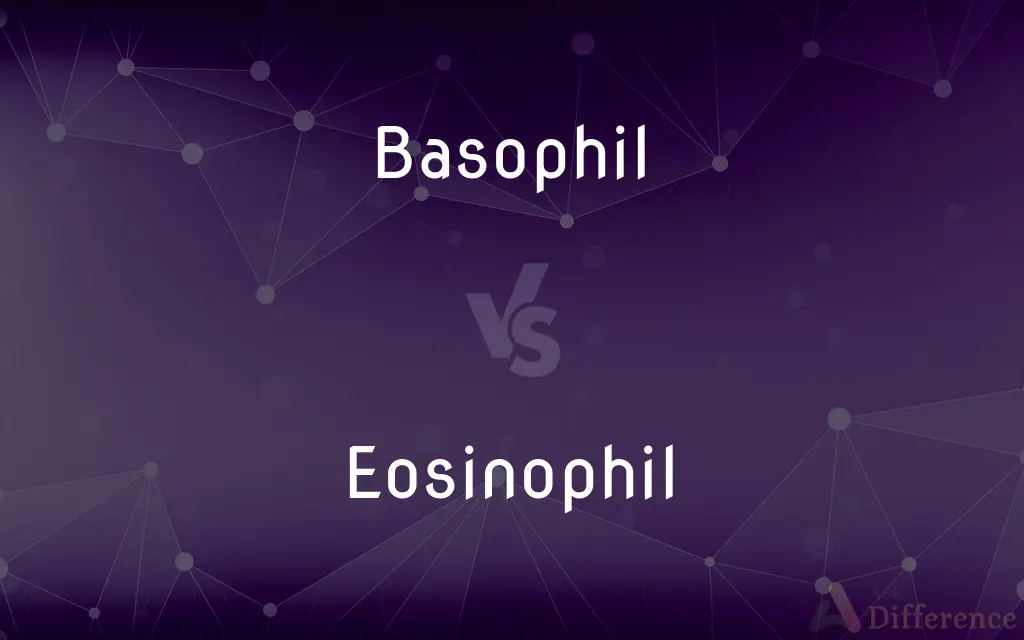Basophil vs. Eosinophil — What's the Difference?
By Tayyaba Rehman — Updated on October 28, 2023
Basophils are white blood cells involved in allergic responses and inflammation; eosinophils combat parasites and also play a role in allergies.

Difference Between Basophil and Eosinophil
Table of Contents
ADVERTISEMENT
Key Differences
Basophils and eosinophils are both types of white blood cells, part of the body's immune system. Basophils are known for their role in allergic reactions and inflammation. They release histamine and heparin, contributing to the body's response to allergens. Eosinophils, while also involved in allergic responses, primarily target parasitic infections and help modulate immune responses.
Basophils are the least common of the white blood cells, making up less than 1% of all white blood cells. Eosinophils are more common than basophils, constituting about 1-3% of white blood cells.
Basophils, when stained in the laboratory, have granules that appear dark blue or purple. Eosinophils, on the other hand, have granules that stain a bright red or orange color.
Basophils play a crucial role in the body's response to allergens and can contribute to the development of asthma and other allergic diseases. Eosinophils are key in fighting against parasitic infections and also contribute to tissue damage in certain allergic diseases.
Due to their roles in immune response, both basophils and eosinophils can be indicators of various health conditions. Elevated levels of basophils might indicate an allergic reaction or chronic inflammation, whereas high eosinophil counts could suggest a parasitic infection or an allergic condition.
ADVERTISEMENT
Comparison Chart
Primary Function
Allergic response, inflammation
Combat parasites, allergic response
Abundance
Less than 1% of white blood cells
1-3% of white blood cells
Staining Color
Dark blue or purple granules
Bright red or orange granules
Role in Allergy and Asthma
Contribute to development
Contribute to tissue damage
Indicator of
Allergic reaction, chronic inflammation
Parasitic infection, allergic condition
Compare with Definitions
Basophil
A type of white blood cell.
Basophils play a vital role in the immune system.
Eosinophil
Targets parasitic infections.
Eosinophil levels rise during a parasitic attack.
Basophil
Involved in allergic responses.
Elevated basophils can indicate allergies.
Eosinophil
More common than basophils.
Eosinophils make up 1-3% of white blood cells.
Basophil
Aids in inflammatory responses.
Basophils release histamine, contributing to inflammation.
Eosinophil
A white blood cell type.
Eosinophils are important in fighting infections.
Basophil
The rarest type of white blood cell.
Basophils are less than 1% of white blood cells.
Eosinophil
Involved in allergic diseases.
High eosinophils can indicate allergic conditions.
Basophil
Contains histamine and heparin granules.
Basophils release granules during allergic reactions.
Eosinophil
Contains bright red granules.
Eosinophils' granules are visible under a microscope.
Basophil
Basophils are a type of white blood cell. Basophils are the least common type of granulocyte, representing about 0.5% to 1% of circulating white blood cells.
Eosinophil
A white blood cell that functions in the immune response by releasing enzymes that can kill parasites and other pathogens. Eosinophils are found chiefly in connective tissue and contain granules that are stained by eosin or other acid dyes.
Basophil
A white blood cell that when activated releases histamine and other substances that are involved in allergic reactions. Basophils are found chiefly in the blood and sites of inflammation and have cytoplasmic granules that are stained with basic dyes.
Eosinophil
Eosinophils, sometimes called eosinophiles or, less commonly, acidophils, are a variety of white blood cells and one of the immune system components responsible for combating multicellular parasites and certain infections in vertebrates. Along with mast cells and basophils, they also control mechanisms associated with allergy and asthma.
Basophil
Basophilic.
Eosinophil
Eosinophilic.
Basophil
(cytology) Any cell that has granules stained by basic stains.
Eosinophil
A white blood cell responsible for combating infection by parasites in the body.
Basophil
A white blood cell responsible for inflammatory reactions during immune response.
Eosinophil
Alternative form of eosinophilic
Basophil
One of the endocrine basophilic cells of the adenohypophysis, including gonadotrophs and thyrotrophs.
Eosinophil
A leukocyte readily stained with eosin
Basophil
A leukocyte with basophilic granules easily stained by basic stains
Common Curiosities
Are basophils found in the bloodstream?
Yes, basophils circulate in the bloodstream.
Can basophil levels fluctuate?
Yes, basophil levels can change in response to allergies or infections.
What triggers basophils to release histamine?
Allergens and certain immune signals trigger basophils.
Do eosinophils play a role in asthma?
Yes, eosinophils can contribute to airway inflammation in asthma.
Are basophils visible under a regular microscope?
Yes, but they are better identified with special stains.
Do eosinophils release substances like basophils?
Yes, eosinophils release substances that modulate immune responses.
Can eosinophils help in diagnosing diseases?
Yes, elevated eosinophils can indicate conditions like parasitic infections or allergies.
Can stress affect basophil levels?
Yes, stress can impact immune cell levels, including basophils.
Are eosinophil disorders treatable?
Yes, many conditions involving eosinophils are treatable.
What does an eosinophil count tell a doctor?
It can indicate possible allergies, infections, or immune disorders.
Can certain foods increase eosinophils?
Yes, foods triggering allergies can increase eosinophil levels.
Can basophils enter tissues?
Yes, basophils can migrate into tissues during immune responses.
Are basophils involved in wound healing?
Basophils can play a role in healing and immune responses to injury.
Do antihistamines affect basophils?
Antihistamines can mitigate the effects of substances released by basophils.
Is an eosinophil count part of a regular blood test?
Yes, it's part of a complete blood count (CBC).
Share Your Discovery

Previous Comparison
Haul vs. Drag
Next Comparison
Gelatin vs. AlbuminAuthor Spotlight
Written by
Tayyaba RehmanTayyaba Rehman is a distinguished writer, currently serving as a primary contributor to askdifference.com. As a researcher in semantics and etymology, Tayyaba's passion for the complexity of languages and their distinctions has found a perfect home on the platform. Tayyaba delves into the intricacies of language, distinguishing between commonly confused words and phrases, thereby providing clarity for readers worldwide.














































